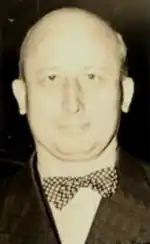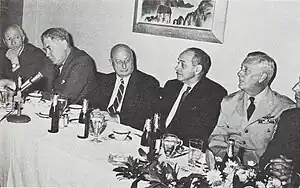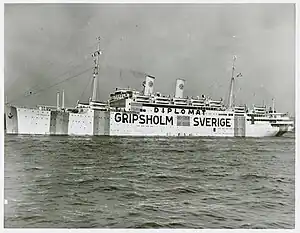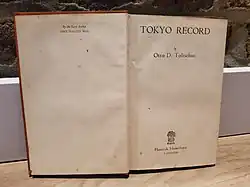Otto D. Tolischus | |
|---|---|
 Otto D. Tolischus of the Berlin Bureau of the New York Times in New York, N.Y. | |
| Born | November 20, 1890 Ruß, East Prussia, Germany (Rusnė, Lithuania) |
| Died | February 24, 1967 New York City, U.S |
| Nationality | German (renounced in 1907), US |
| Education | Columbia University |
| Occupation(s) | journalist, author |
| Spouse | Naya Grecia (1949–1967, his death)[1] |
| Parent(s) | David Tolischus and Maria Tolischus (née Kubillus) |
Otto David Tolischus (November 20, 1890 – February 24, 1967) was a Prussian-Lithuanian-born journalist for the New York Times and winner of the 1940 Pulitzer Prize for Correspondence for his writing and reporting from Berlin before and during World War II.[2] Tolischus started his journalistic career in Cleveland Press and went on to work as a foreign correspondent in Berlin and London for Universal Service and International News Service.
Biography
Tolischus was born in Russ, East Prussia, German Empire (after 1919 Memel Territory, now - part of Lithuania). Tolischus’ parents, David and Maria (née Kubillus) were local farmers and belonged to an ethnic minority of Prussian Lithuanians, also known as Memelanders. His father was a village elder in Russ.[3] Tolischus came from a big family of five brothers and one sister. Tolischus studied at the local state school in Russ and worked as a secretary in the lawyer’s office.
In 1907 Tolischus emigrated to the United States.[4] Tolischus renounced his German citizenship and became a U. S. citizen when his father David Tolischus was naturalised in 1907.[5] Three of his brothers, John (Johann), William and Edward C., moved to the USA around the same time.[6]
After the arrival Tolischus worked in a printing house in Syracuse (N.Y.) and later in a factory plant in Trenton (N.J.).[7] In 1912 Tolischus enrolled into a newly established School of Journalism in Columbia University for a 4 year course of journalism.[8] He was one of the 79 students who joined the first class of the school. In 1917 Tolischus was awarded the first travelling scholarship from the Columbia School of Journalism along with other students, Geddes Smith and David S. Levy.[9] The award was postponed because of the First World War and never collected by the recipients.
In 1916 Tolischus joined Cleveland Press as a cub correspondent. Tolischus started this work on the same day as John M. Gleissner (later - managing editor of The Washington Daily News).[10] In 1918 Tolischus was called to serve in the US military service. He joined the Training Corps of Camp Gordon, near Atlanta, Georgia. There Tolischus was promoted to a sergeant in September 1918.[11] However, the Armistice came before Tolischus’ transfer into active service in France. In 1918 Tolischus returned to Cleveland Press. He was later promoted to managing editor of the newspaper.
Universal Service and International News Service (1923-1932)
News services

In 1923 Tolischus returned to Europe and joined wireless news service as a staff correspondent of Universal News Service (Universal Service) in Berlin, part of the W. R. Hearst's news and media empire. In June 1927 Tolischus moved to the International News Service (INS) as a chief correspondent in Berlin (eventually, both Hearst's outlets, Universal Service and INS, will merge into INS in 1937).[13] By 1928 Tolischus was promoted to the Central European Director of INS.
Reporting news from Europe
On his first overseas assignment, Tolischus covered Hitler's failed 1923 putsch in Munich.[14] He reported from various locations in Munich and interviewed general Ludendorff and his confidants, doctor Rudolf Butmann and captain Wilhelm Weiss.[15] During his time with the Universal Service and INS, Tolischus travelled extensively across different parts of Northern, Central and Eastern Europe. He was in Stockholm in November 1926 to cover the wedding of Crown Prince Leopold of Belgium and Princess Astrid of Sweden. [16] At a short notice, Tolischus travelled from Berlin to cover socialist revolt in Vienna in July 1927 and the death of King Ferdinand I of Romania in Bucharest.[17] In the first half of 1930 Tolischus visited Russia and described conditions in USSR and Moscow news situation (in a letter to Barry Faris, June 17, 1930).[18]
Head of International News Service in London
In 1931 Tolischus was transferred to London and promoted to the Bureau Chief of INS there; it meant that Tolischus was put in charge of all INS European news coverage. In London he was accompanied and installed by George H. Hargreaves, the vice president and general business manager of INS.[19] In 1932 Tolischus left INS and returned to the USA. In London's INS bureau Tolischus was succeeded by Harry K. Reynolds (1933-34) and William Hillman (1934-38).[20]
Correspondent in Berlin (1933-1940)
After some time back in the US, Tolischus joined the Berlin bureau of the New York Times in spring 1933, where he chronicled the rise of Nazi Germany. At that time the New York Times team in Berlin was headed by Swiss-born bureau chief Guido Enderis, along with chief European correspondent Frederick T. Birchall (Birchall was recently installed by Arthur Hays Sulzberger to strengthen the newspaper's coverage of Nazi Germany). During the pre-war years, Birchall, Enderis and Tolischus provided the majority of the Times' coverage from Germany. Robert Crozier Long also wrote on financial matters until his death in 1938, after which a young reporter named C. Brooks Peters was hired as a new addition to the Berlin team. After Long’s death, Tolischus was expected to start providing financial coverage for which he requested additional compensation from Sulzberger.[21]
In Germany Tolischus witnessed the expansion of the Nazi regime and reported on its economic, political and cultural aspects. Before the war, he made detailed studies of Poland and Czechoslovakia, traveling extensively in both countries. He predicted the Nazi-Soviet Pact three months before it was signed and covered the German perspective on the outbreak of World War II.[22]
Within two days of the secret signing of the Molotov–Ribbentrop Pact he had managed to get news of it for a page-one story called "Nazi Talks Secret" whose subtitle included "Soviet and Reich Agree on East."[23] On 26 August 1939, he filed a story that noted Nazi troops on the move near Gleiwitz (now Gliwice), which led to the Gleiwitz incident, a false flag operation, on 31 August 1939.[24] (On 28 August 1939, the Times was still reporting on fears of a Gleiwitz raid.)[25] In 1940, he was expelled from Germany.[4]
Correspondent in Tokyo (1941-1942)
On the 25th of January 1941 Edwin L. James, managing editor of the New York Times, announced that Tolischus will sail for Japan to join the Tokyo bureau as a correspondent for the New York Times and The Times.[26] After his expulsion from Berlin by the Nazi government, Tolischus admitted to being delighted to take this opportunity. While he was well-aware that war clouds appeared to be gathering over the Pacific, he was eager to take a look at the other end of the Berlin-Tokyo axis. In particular, Tolischus noted, he was keen to learn 'how much truth there was in the story that the Nazis had taken over some of their mystic ideas from the Japanese'.[27]

Tolischus left San Francisco on the SS President Coolidge and sailed into Tokyo on February 7th. Tolischus arrived to replace Hugh Byas, a long-serving the New York Times correspondent in Tokyo. On arrival Tolischus was met by a group of local Japanese newspaper reporters. Later Tolischus learned that he was not entirely unknown in Japan. According to Tolischus, the Japan Times Advertiser and other Japanese newspapers used many of his articles sent to the New York Times from Germany.[29]
During his first week in Tokyo, Tolischus visited the American Embassy and paid his respects to ambassador Joseph C. Grew. He also paid visits at the offices of Japan's two biggest newspapers: Asahi and Nichi Nichi (Tolischus presented a letter of introduction from Roy Howard to Shingoro Takaishi, the chief of Nichi Nichi).[30]
Tolischus was surprised to discover that from the beginning of his stay Japan looked like a country already under a state of war. Tolischus drew comparisons with Germany at war and indicated the same symptoms: Tokyo had a city wide dim-out, there were shortages and queues for food shops and low number of taxis. It was clear that the Japanese people were already feeling the effects of the conflict in China. [31]
Arrest and imprisonment after the attack on Pearl Harbor
A few hours after the Japanese attack on Pearl Harbor on the 8th of December, Tolischus was arrested and imprisoned for five months, where he was regularly beaten and tortured. During this period of imprisonment, the Japanese manager of the Times Tokyo Bureau, Junnosuke Ofusa, took food and clothes to Tolischus. The ongoing contact continued until Tolischus was sent to the United States as part of a prisoner exchange in 1942.[32]
Internment and evacuation on the Asama Maru and Gripsholm
After six months of imprisonment Tolischus was released by the Japanese authorities on May 20, 1942. Instead of the full release, Tolischus was escorted to the internment camp at Sumire, located between Tokyo and Yokohama (previously a Catholic girls' school). In his account Tolischus noted that the original group of internees at Sumire were thirteen Americans, also British, Dutch, Belgians and French Canadians. Most of the internees were Catholic priests. Among Americans there were Leo Chamberlain (National City Bank), journalists Robert Bellaire (United Press), Joseph E. Dynan (Associated Press) and Colvin (Tom) Crichton (Universal News Features). On June 2 the camp received Wall Street Journal's team members: Max Hill, Richard Tenelly and Raymond Cromley. Just like Tolischus, all of them were given the same suspended sentence.[33]
In the camp Tolischus was informed that some of the internees are going to be repatriated on the ship Asama Maru in the middle of June. This was confirmed by father Hilderbrand Yaiser, the Benedictine, who acted as an attache of Swiss embassy in Tokyo (he confirmed that the internees would depart on June 17; they were allowed any amount of baggage and 1000 yen). On the day of the departure, Tolischus and other internees were taken by a special train to Yokohama to board the Asama Maru. Tolischus and other passengers boarded the ship which left the dock but stayed anchored in the Tokyo Bay for another week before departing on June 25.[34]
The Asama Maru reached Hong Kong on June 29 and anchored opposite Stanley Fort. 377 evacuees, most of them Americans, boarded the ship (including A. E. Southward, the consul general and Alberto Perez-Saez, the consul general of Peru). On July 2 the Asama Maru anchored next to Saigon. On July 6 the Asama Maru was joined by another evacuation ship - the Conte Verde (travelling from Shanghai ).[35]

The Asama Maru sailed into Maputo (Lourenco Marques) on July 22. The following day Tolischus with the rest of the evacuees was transferred to the Gripsholm while the Japanese passengers walked from it to the Asama Maru. During his time in Maputo, Tolishus attempted to send his stories about torture and imprisonment from the local telegraph office. He filed two copies: one to New York and another to London (The Times); unfortunately, the stories did not reach New York.[36]
The Gripsholm departed Maputo on July 28 and reached Rio de Janeiro on August 10. In Rio de Janeiro Tolischus telegraphed his stories to New York. In Rio de Janeiro he was met and assisted by Frank Garcia, the New York Times Rio correspondent. The last leg of the sailing took place from August 11 to 25. Tolischus sailed on the Gripsholm into New York at dawn.[37] More details about this evacuation trip was recorded by Max Hill in his book Exchange Ship, published immediately after the event in 1942.[38]
Career in the New York Times
Tolischus was a member of the Times editorial board until his retirement in 1964.[1] Tolischus died of cancer in 1967.[2]
Works

Based on his experience as a journalist, Tolischus wrote three books on World War II:
- 1940 -- They Wanted War. New York: Reynal and Hitchcock.
- 1943 -- Tokyo Record. New York: Reynald and Hitchcock.
- 1945 -- Through Japanese Eyes. New York: Reynald and Hitchcock.
References
- 1 2 "Tolischus, Pulitzer Prize Reporter, Dies". The Indianapolis Star. 25 February 1967. p. 23. Retrieved 9 January 2019.
- 1 2 "Otto D. Tolischus of Times, 76, Dies: Correspondent Tortured in Japan - Won '40 Pulitzer". The New York Times. 25 February 1967. p. 22. Retrieved 9 January 2019.
- ↑ https://www.mle.lt/straipsniai/jonas-tolisius
- 1 2 Brennan, Elizabeth A.; Clarage, Elizabeth C. (1999). Who's who of Pulitzer Prize Winners. Oryx Press. p. 76. ISBN 1-57356-111-8.
- ↑ https://content.time.com/time/subscriber/article/0,33009,764310-1,00.html
- ↑ https://www.mle.lt/straipsniai/jonas-tolisius; The New York Times, September 30, 1949, page 23 (obituary of Edward C. Tolischus); The New York Times, December 14, 1965, page 43 (obituary of William Tolischus)
- ↑ Reporting World War II. Part One. American Journalism 1938-1944, advisory board: Samuel Hynes, Anne Matthews, Nancy Caldwell Sorel, Roger J. Spiller, The Library of America, 77, New York: page 861.
- ↑ "Columbia Spectator 18 December 1941 — Columbia Spectator". spectatorarchive.library.columbia.edu. Retrieved 2022-08-13.
- ↑ BOYLAN, J. 2003. Pulitzer's School: Columbia University's School of Journalism, 1903-2003: 52-3.
- ↑ BRENNAN, E. A. and CLARAGE, E. C. 1999. Who's who of Pulitzer Prize Winners: 76; The Editor and Publisher, 1916-09-16: Vol 49 Issue 14, page 25 (Favors Journalism Graduates)
- ↑ The Constitution News from Gordon and the Other Camps, September 5, 1918, page: 1 (Many Men Promoted in Second Regiment).
- ↑ International News Service's publicity photo, published by Editor and Publisher, 1931-06-13, Vol. 64, Issue 4, p.12.
- ↑ The New York Times, August 15, 1937, Hearst consolidates two news services, p. 8.
- ↑ Edward W. Barrett (comp.), 1963, "Journalists in Action", Channel Press, Manhasset, New York, p. 116
- ↑ The San Francisco Examiner, Tuesday, November 13,1923, Otto D. Tolischus, 'Ludendorff Bares Secrets of Coup. Treachery in Bavarian Revolt', p. 2.
- ↑ Atlantic City Daily Press, November 4, 1926, Notables Gather for Royal Wedding, p. 2.
- ↑ Editor & Publisher, August 20, 1927, Vol. 60, No. 13, p. 13.
- ↑ Wisconsin Historical Library and Archives: Otto D. Tolischus papers, 1926-1942: https://digicoll.library.wisc.edu/cgi/f/findaid/findaid-idx?c=wiarchives;cc=wiarchives;view=text;rgn=main;didno=uw-whs-us8af32
- ↑ Editor & Publisher, June 13, 1931, Vol. 64, No. 4, p. 12.
- ↑ Desmond, R. W. 1982. Crisis and Conflict. World News Reporting Between Two Wars, 1920-1940, p. 245.
- ↑ Leff, L. 2005, Buried by the Times. The Holocaust and America’s Most Important Newspaper, Cambridge University Press, p. 56.
- ↑ Fischer, H. F. 1987, International Reporting, 1928-1985 from the Activities of the League of Nations to Present-day Global Problems, Volume 1, p. 67.
- ↑ Tolischus, Otto D. (25 August 1939). "Nazi Talks Secret: Hitler Lays Plans with His Close Aides for the Partition of Poland". New York Times. p. 1. Retrieved 2 January 2019.
- ↑ Tolischus, Otto D. (26 August 1939). "Berlin Talks Held: Nazi Quarters Now Feel General European war Has Been Averted". New York Times. p. 1. Retrieved 2 January 2019.
- ↑ "Polish Made Easy for Reich Troops: Booklet on Sale Has Phonetic Aid—'Good Day, Mr. Mayor' Is the Opening Phrase: GLEIWITZ FEARS RAIDS". New York Times. 28 August 1939. p. 2. Retrieved 2 January 2019.
- ↑ Editor and Publisher, 1941-01-2,: Vol 74, Issue 4: 29; Tolischus, D. Otto, Tokyo Record, Hamish Hamilton, London: 9.
- ↑ Tolischus, D. Otto, Tokyo Record, Hamish Hamilton, London: 9.
- ↑ The Overseas Press Bulletin, Vol. 13, No. 40, October 4, 1958, p. 1.
- ↑ Tolischus, D. Otto, Tokyo Record, Hamish Hamilton, London: 12.
- ↑ Tolischus, D. Otto, Tokyo Record, Hamish Hamilton, London: 21.
- ↑ Tolischus, D. Otto, Tokyo Record, Hamish Hamilton, London: 14.
- ↑ Sanger, David. "Junnosuke Ofusa, Long the Manager For Times in Tokyo", New York Times, March 30, 1994.
- ↑ Tolischus, D. Otto, Tokyo Record, Hamish Hamilton, London: 263-266.
- ↑ Tolischus, D. Otto, Tokyo Record, Hamish Hamilton, London: 266; 269.
- ↑ Tolischus, D. Otto, Tokyo Record, Hamish Hamilton, London: 271-272.
- ↑ Tolischus, D. Otto, Tokyo Record, Hamish Hamilton, London: 274-275.
- ↑ Tolischus, D. Otto, Tokyo Record, Hamish Hamilton, London: 276-279.
- ↑ Max Hill (1942) Exchange Ship, Farrar & Rinehart, Inc. New York, Toronto.
External sources
- Brown, John Mason. "Book Review: They Wanted War by Otto D. Tolischus," The American Political Science Review, Vol. 35, No. 3 (Jun., 1941), pp. 573–574.
- Clyde, Paul H., "Book Review: Through Japanese Eyes by Otto D. Tolischus," The American Political Science Review, Vol. 39, No. 4 (Aug., 1945), pp. 808–809.
- MacNair, Harley Farnsworth, "Book Review: Through Japanese Eyes by Otto D. Tolischus," The Pacific Historical Review, Vol. 15, No. 4 (Dec., 1946), pp. 465–466.
- Soward, F.H. "Book Review: Tokyo Record by Otto D. Tolischus," The Far Eastern Quarterly, Vol. 2, No. 4 (Aug., 1943), pp. 388–389.
- Otto David Tolischus papers at the University of Oregon